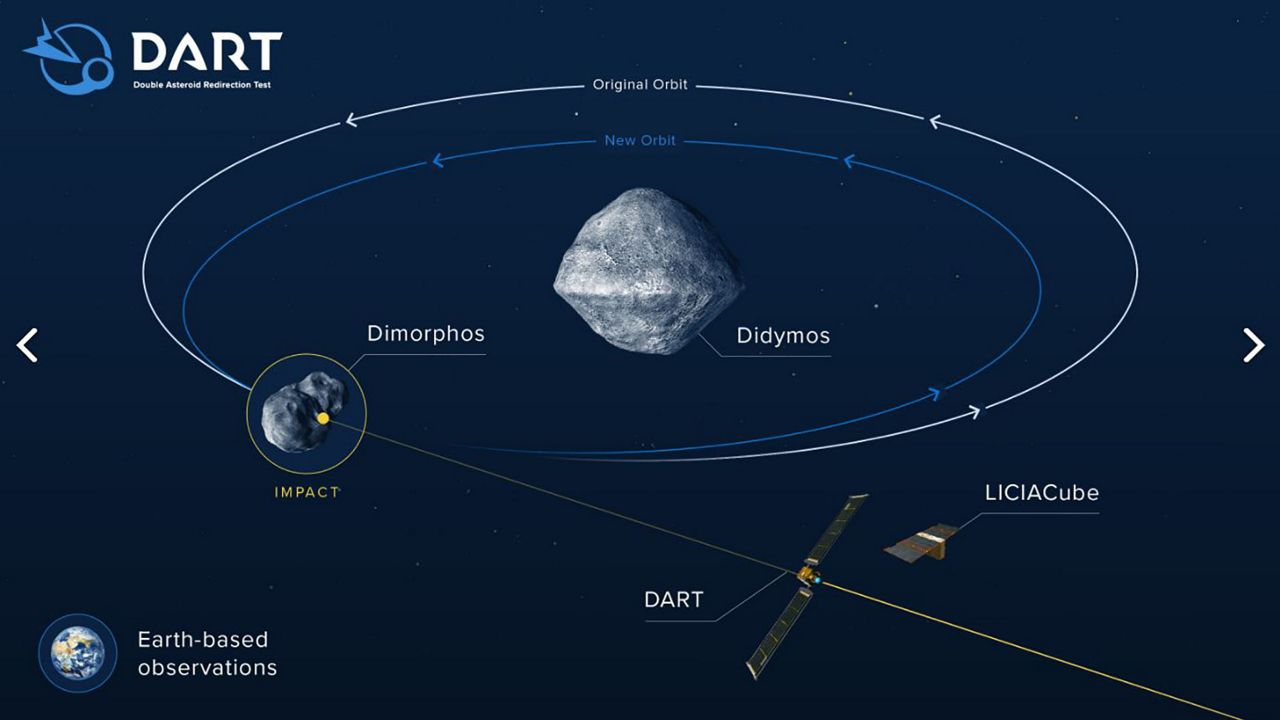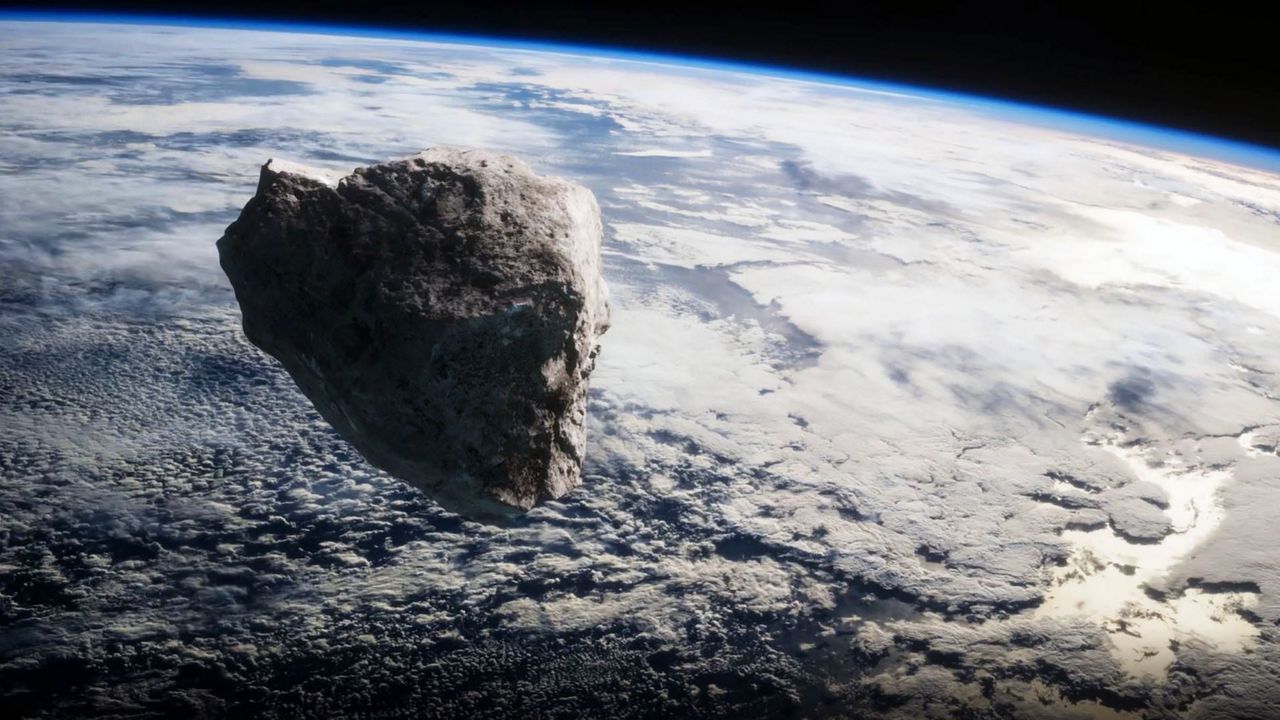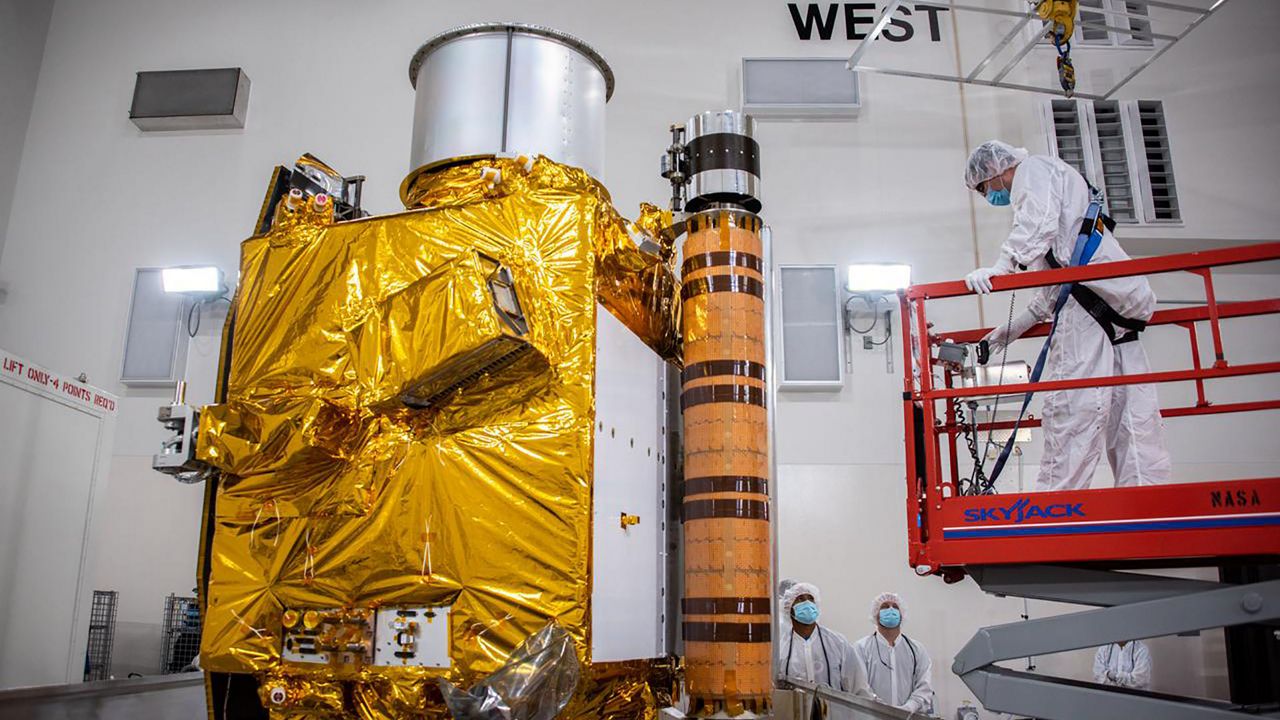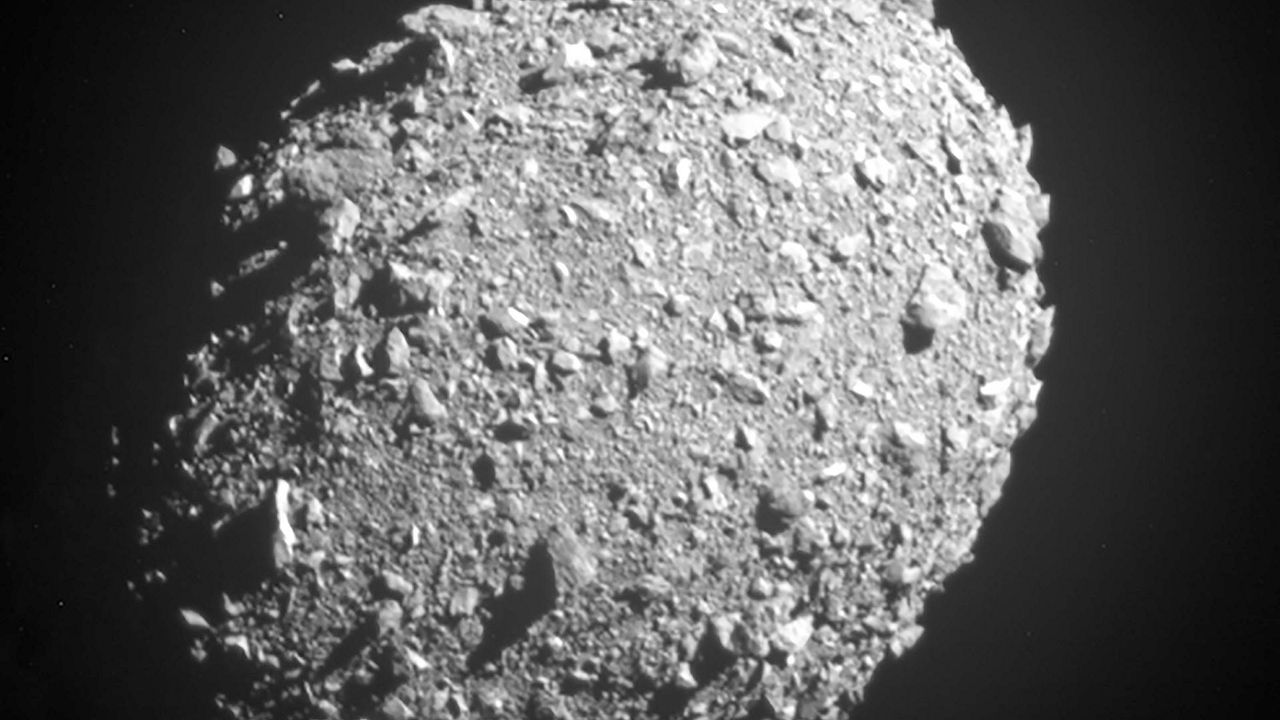NASA successfully crashed the DART spacecraft into the asteroid Dimorphos in a one-way mission to redirect its orbit as part of a planetary defense test on Monday night.
What You Need To Know
- The DART spacecraft slammed into an asteroid
- Test asteroid is not a threat to Earth
- This is the first time in history that humans have struck an asteroid with a spacecraft
- LICIACube spacecraft followed DART to its final destination
- DART Mission leads Andy Rivkin and Justin Atchison explain the mission
- WATCH Justin Atchison interview about the DART mission ▼
- Scroll down for the following:
- Why Dimorphos?▼
- DART isn’t alone ▼
- So, why not a missile? ▼
- What if Dimorphos hit the Earth? ▼
- Why Dimorphos?▼
- DART isn’t alone ▼
- So, why not a missile? ▼
- What if Dimorphos hit the Earth? ▼
The DART was used as a battering ram at speeds of nearly 4 miles per second as it struck Dimorphos, which was seen during a live feed from the spacecraft itself. This is the first time in history that humans have struck an asteroid with a spacecraft.
IMPACT SUCCESS! Watch from #DARTMIssion’s DRACO Camera, as the vending machine-sized spacecraft successfully collides with asteroid Dimorphos, which is the size of a football stadium and poses no threat to Earth. pic.twitter.com/7bXipPkjWD
— NASA (@NASA) September 26, 2022
The purpose of this demonstration is to see if Dimorphos’ orbit of a bigger asteroid Didymos will be altered, according to two mission leaders in an interview with Spectrum News before the test took place.
Researchers will have to wait to fully determine just how successful the mission was in its effort to change Dimorphos' orbit.
But NASA researchers waited nearly a year since SpaceX launched their Double Asteroid Redirection Test (DART) mission in November of 2021 to determine if a spacecraft can collide with a guinea pig asteroid to knock it off its course.
Built and managed by the Johns Hopkins Applied Physics Laboratory for NASA, the DART spacecraft spent about 10 months on a one-way trip to the asteroid Didymos’ small moon Dimorphos, which is also considered an asteroid.
Understanding the DART mission
Specs about DART spacecraft:
- DART without solar arrays: 6.2 feet in length × 5.9 feet in width × 8.5 feet in height
- Solar arrays: Each is 27.9 feet long
- Weight during impact: 1,260 pounds
- Speed of impact: 3.8 miles per second

Why Dimorphos?
The binary asteroid system is only made up of Didymos, about half a mile in diameter, and the small moon (sometimes called a moonlet) Dimorphos, which has a diameter of 525 feet and is the target of this little experiment.
As the dynamic duo orbits the sun, they can range as close to Earth as almost half an AU to about 3 AU away, which is just shy beyond the orbit of Mars.
(Not sure what an AU is? It stands for “astronomical unit” and one AU is the same distance from the sun to the Earth or about 93 million miles.)
At the time of impact, Dimorphos will be just a mere 6.8 million miles from Earth, practically a walk around the block in space terms.
The impact took place at around 7:14 p.m. EDT, on Monday, Sept. 26, as the DART spacecraft was used as a missile as it was speeding at nearly 4 miles per second when it struck Dimorphos.
“The spacecraft is going to be steering itself into the asteroid and what we hope to see tonight is amazing images of an asteroid we’ve never seen before, getting closer and closer and closer and then nothing and that means success,” explained DART Mission Design leader Justin Atchison in an interview with Spectrum News, which can be seen in the embedded video above.
The energy that was released by DART was the same as 2.5 tons of TNT, Dr. Andy Rivkin, the DART investigation team co-lead at the Johns Hopkins Applied Physics Laboratory, explained to Spectrum News.
“Unlike the chemical energy of TNT or electrical energy of lightning, DART’s energy is released in a shockwave generated from its deceleration from 4 miles a second to zero,” he said.
This pair was selected to help determine just how much of an impact the DART spacecraft would make on Dimorphos’ orbit once the cosmic collision occurs.
“We’re interested in seeing how asteroids respond to being whacked into — in more technical terms, we want to know just how much the orbit of Dimorphos around Didymos changes compared to the known momentum that the DART spacecraft will give it when they collide,” Rivkin said.
In fact, scientists believe the collision will change the speed of Dimorphos by a fraction of 1% and it should change its orbit around the larger Didymos by minutes, NASA described.
“Dimorphos currently takes a bit less than 12 hours to orbit Didymos. We expect DART to change that period by about 10 minutes, though it could be a little less or much more,” explained Rivkin.

DART isn’t alone
How will DART’s historical moment be captured? With a little traveling companion, courtesy of the Italian Space Agency.
And it is little: DART released a shoebox-side CubeSat called the Light Italian Cubesat for Imaging of Asteroids or LICIACube for short.
This secondary spacecraft was deployed days ago and it will record the collision caused by DART, study the plume formation and its dissipation rate that was created due to the crash, and take measurements of the size of the crater that DART will leave behind, among other things, according to the Italian Space Agency.
And, of course, take pictures.
Rivkin explained more about LICIACube’s mission.
“The LICIACube cubesat is about the size of a cereal box, and was contributed by the Italian Space Agency. It has two cameras, named LUKE and LEIA,” he stated. “LICIACube’s goals are to get images of the debris cloud we expect DART to make after hitting Dimorphos, and get images of the side of Dimorphos that DART won’t see.”
But do not expect to see the spectacular crash live from LICIACube. Rivin described that LICIACube has a very small antenna and it can only send a number of images a day.
“Hopefully, we’ll be able to see the first one on Earth after a couple of days, but the Italian team might need some time to analyze and calibrate the images before releasing them,” the planetary astronomer confirmed.
In fact, people of Earth will have to wait for those images to be released since even the standard telescope may not be powerful enough to see Didymos, said Rivkin.
“In brief, we don’t think Didymos will be visible through an eyepiece for a typical backyard telescope, but it should be relatively easily detected for people who have cameras attached to their telescopes,” he said, adding that the duo asteroid system may appear brighter after the impact, but not by much.
Speaking of images, DART had its own onboard camera called Didymos Reconnaissance and Asteroid Camera for Optical navigation, or DRACO.
Not only did it help navigate DART to the binary asteroid system on its own and measure the shape and size of the moonlet, but it streamed images back to Earth before the galactic fender-bender, according to information from Johns Hopkins.
In fact, for Atchison, it is the guidance system that DART is using to direct itself to its final target was one of the trickier parts of the mission.
“The hardest part really is this autonomous guidance because there are just so many pieces that all have to work and we get one shot at it. We’ve never done this before. We’ve never seen the asteroid before and we’re coming in so fast. There’s no turning around and going back for a second shot,” the aerospace engineer said.

So, why not a missile?
Anyone who has ever seen a Hollywood movie of a doomsday asteroid heading to Earth may be thinking, “Why not shoot it with a missile?”
In a sense, the DART mission team did just that, said Rivkin: the spacecraft is a missile, just not armed.
But a traditional missile, especially a nuclear one, may not be the best method, explained Rivkin.
“The conventional wisdom among planetary defenders is that we usually don’t want to destroy asteroids, but move them as one piece if we can. Using explosives might pack a bigger punch, but also would run the risk of destroying the asteroid and leaving a lot of debris that still might hit the Earth and be hard to keep track of in the meantime. If we do need that bigger punch, the most powerful tool we have is a nuclear device. However, it’s against international law to test those in space, and a lot of people are very uncomfortable with relying on them. So, the kinetic impactor technique that DART is testing out is a great addition to our arsenal.”
How about a tow?
Since blowing up an asteroid is out of the question, why not have a spacecraft attach cables to the space rock and tow it to a different location? Well, that is a “no” for a few reasons, Rivkin revealed.
First, not all asteroids are solid rocks, but a mix of gravel, sand and boulders, he said.
“So, rather than cables, you’d probably need to put a bag or very fine mesh over the asteroid,” he said.
Plus, you have to consider the movement of the asteroid, as some just do not lazily float along in space. They spin and very rapidly, the doctor of planetary sciences said, who pointed out that a spacecraft would first need to stop the asteroid from moving first or else the bag or mesh would break.
But there is a concept that is being considered called “gravity tractor” but tests for that might be in a few decades, he said.
“… you’d spend a whole lot of energy with the rocket giving the tow. However, there are some concepts that people have that use a very, very massive spacecraft to ‘tow’ the asteroid using the spacecraft’s own gravity rather than cables!” Rivkin exclaimed.

What if Dimorphos hit the Earth?
Remember earlier when it was mentioned that Dimorphos has a diameter of 525 feet? While we have the ability to see something that size coming from decades off, said Rivkin, something that size can still do some major damage if it fell to Earth.
“The spot where it hit would end up as a crater perhaps a mile wide, and there would be devastation for 50 or more miles. It would be a natural disaster unparalleled in human history if it were to hit a city with no warning,” he said.
Now, something bigger, say half a mile in size, were to hit the Earth? That would ruin humankind’s vacation plans.
But Rivkin reassured something that size does not happen often.
“Something about a half-mile in size, which is big enough to threaten human civilization, hits the earth about twice every million years. We know where all of those objects are, and none are in orbits we need to worry about. We do expect that it will eventually happen, but it will probably be tens of thousands of years in the future or more, and I’m confident that humankind will have the tools to deal with it then,” he said.
And by the off chance astronomers did not notice a half-a-mile-sized asteroid heading to Earth, it might take NASA and other space agencies a year or two to build a DART-like spacecraft and they might build more than one, said Rivkin.



